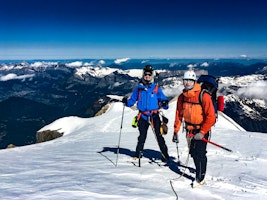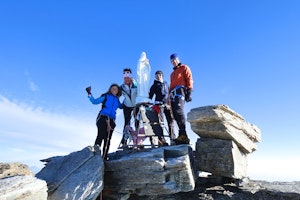Mountain biking is the activity of riding a bicycle on different kinds of off-road trails. It requires endurance, speed, balance and technical skills to navigate through rough terrains. Unlike road bikers, mountain bikers pursue obstacles and see the world as a natural and challenging playground full of winding trails. Vertical downhill sections, steep ascents, loose rocks, water crossings, tree roots: everything is an opportunity to put their abilities to the test!
There are different mountain biking disciplines, ranging from adrenaline-pumping descents to gentle rides on scenic forest trails. Whether you are a seasoned biker or a complete beginner, you are likely to find a perfect trail to match your level and abilities. For those who are new to mountain biking, going out with a guide is highly recommended.
Knowing how to handle a mountain bike, as well as feeling comfortable and confident with the equipment ―from the bike’s saddle, the height of pedals, the brakes and the position of the helmet― is essential for this activity. Being able to fix any mechanical problems that may occur along the way is another necessary skill.
Mountain biking is a dynamic sport that involves a total body workout. On a ride you not only work out your legs and strengthens your heart and lungs, but also exercises your upper body (when climbing with your bike or maneuvering with your arms). Cycling also boosts riders' balance, coordination and stability.
Exploring the outdoors and changing scenery on every ride makes mountain biking also a mentally relaxing and stress-relieving activity.

Some people take mountain biking as a sport, join mountain biking races and are always looking for new thrilling paths and adventures round the globe. Others, simply enjoy riding as a pleasurable activity that allows them to exercise and feel connected with nature.
Feeling excited to hit the off-road? Make sure to check your equipment carefully, pick up a trail according to your level and stay hydrated throughout the way. Enjoy the ride!
Types of Mountain Biking

Trail riding is a recreational form of cycling. It’s all about a pleasurable ride on marked trails, including uphill and downhill sections.
Cross-country cycling (or XC) is the most popular discipline of mountain biking and also the less extreme. It consists on completing a defined round circuit or point-to-point long trail, on a terrain that can range from a single track ―a narrow trail to fit one rider at a time―, to fire roads or even paved roads. There are technical sections defined by either natural or man-made obstacles. The sport requires endurance and very good bike handling skills, but it does not focus too much on speed. The bikes used for cross-country cycling are lightweight.
Downhill biking is a thrilling type of mountain biking, which focuses on descending a trail at a very high speed. Usually, bikers reach a mountain peak by using a car or a lift, and then race down on their bikes. Ski resorts during summer months are an ideal setting for this. When riding downhill, bikers are standing up, so the workout is very much tiring. Downhill bikes have a full suspension, are heavier than cross-country bikes and specially prepared for high-speed descents.
All mountain combines the best of two worlds: cross-country cycling and downhill. It implies riding on a natural terrain full of obstacles, either up a mountain and downhill.
‘Enduro’ refers to a specific competition born in Europe, which consists on different stages that a rider has to complete, including both uphills and downhills. It’s the same as ‘all mountain’ except for the fact that you are racing.
When is the best time to go mountain biking?

Mountain biking is an all-year-round activity. The same place can look very different depending on the time of the year and the weather conditions, but that just about what makes mountain biking so challenging and exciting. With the exception of icy paths ―which are obviously dangerous to ride― even riding on snow can be an enjoyable experience if you have the guts to venture into the outdoors!
Mountain biking trails at National Parks or any types of protected areas are regularly under maintenance. Sometimes the trails can be closed if the weather is too wet, making the trail too muddy and unsafe for the riders, as well as damaging for the trail itself. Trail closures are common during the rainy months. Depending on the location, some trails can close during the winter season and reopen on early spring.
What equipment do you need?

Mountain bike. As we mentioned before, there are different types of bikes (downhill, enduro, cross-country, etc) depending on the cycling discipline you are up to. Some other terms you may hear in the mountain biking world are: ‘fat bikes’, which are especially useful for riding snowy trails and also on sand and mud; ‘E-Bikes’, a regular bike with a battery-powered motor to make pedaling easier. E-Bikes are rising their popularity all around the world, specially among less-frequent riders.
Mountain bike helmet. Never, ever, ride without a helmet! There’s a high risk of falling when mountain biking, so head protection is key. The characteristics of the helmet will be different depending on the type of cycling. Downhill biking, for example, is considered extremely risky so it requires a maximum protection.
Knee pads, elbow pads and riding gloves.
Footwear. Waterproof shoes, with good grips for hiking and comfortable for using the bike’s pedals.
Protective glasses.
Hydration packs are commonly used for mountain biking. Another items you can take include food, an aid supply, sunscreen, maps or GPS, extra clothing and a bike-repair kit.
Why should you hire a guide for mountain biking?

When you are traveling to a unknown destination, hitting the off-road with a mountain guide is your best chance to have an enjoyable experience. A guide knows different trails on the area and can advise you on which one to choose depending on your experience, skills and wishes. He/she can also manage all the logistics of the trip, provide a vehicle to get to the trail-head or as a support during the ride and help you go through any difficulties you may have along the way.
Besides, you will have the chance of improving your skills, challenge yourself on different types of terrain while feeling safe, and enjoy outstanding mountain views!
Top spots for mountain biking in the world

French Alps. From the iconic Tour du Mont Blanc to incredible mountain biking trails in the Ecrins, Queyras or Vercors, the French Alps provide endless terrain for those who enjoy cycling!
Julian Alps (Slovenia). Slovenia boasts is an exciting bike-friendly country, with hundreds of marked cycling routes on beautiful mountain settings. Bled, Kranjska Gora and Triglav National Park are the top mountain biking locations.
Iceland. Perhaps not the first country that springs to mind when it comes to mountain biking, Iceland do has breathtaking landscapes and a rugged terrain of fjords and forests to explore on two wheels.
Andes Mountains (Argentina). Bariloche and San Martin de los Andes are home to some of the most legendary mountain biking trails in Central Patagonia. Join an exhilarating mountain bike traverse and discover amazing places!
Italy. From the stunning Dolomites to the wild coast of Sardinia, Italy boasts mountain biking trails for all tastes and levels.
Check out all the programs available at Explore-Share and book your next mountain biking adventure around the world!







